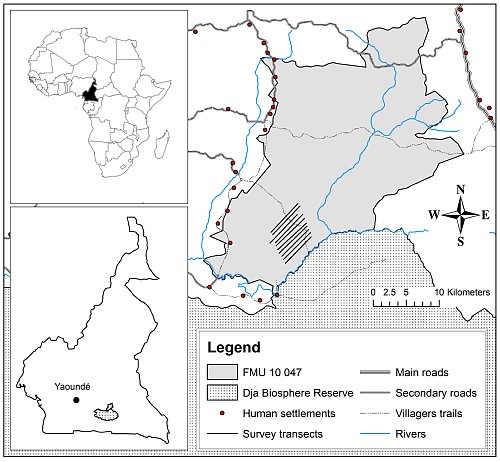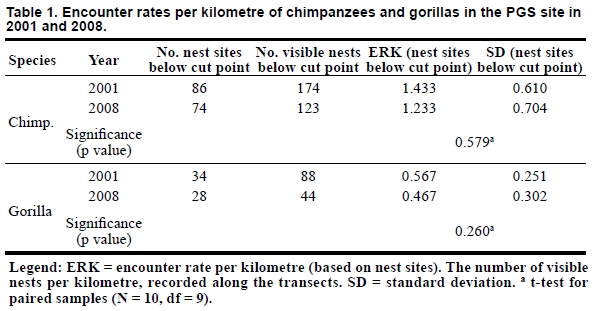|
<NOTE>
Evaluating the Effectiveness of a 10-Year Old Great Ape Conservation Project in Cameroon
Nikki Tagg1,2, Charles-Albert Petre3,4 & Jacob Willie1
1 Projet Grands Singes, Cameroon, Cameroon. 2 Centre for Research and Conservation, Royal Zoological Society of Antwerp, Belgium. 3 Liège University, Belgium. 4 Gembloux Agro-Bio Tech, Belgium. The world faces a massive human-accelerated biodiversity decline. Western lowland gorillas (Gorilla gorilla gorilla) and central chimpanzees (Pan troglodytes troglodytes) are heavily concerned by this decline, with a range-wide mean of 50% having perished1,2, due to hunting for meat, disease and habitat loss and disturbance3,4,5,6. A large majority (approximately 80%) of all remaining populations of chimpanzees and gorillas live outside protected areas (PAs)7,8 where human pressures are high. A serious everyday threat to great ape survival is hunting for meat3 and as a result of the poverty of an ever-growing local population with a taste for game meat, traditional bushmeat hunting has become more and more driven by economic forces9. In the Dja Biosphere Reserve (DBR) it has been noted that all large and medium-sized mammalian species (except galagos and pottos) are hunted for human consumption10; that wildlife is the source of 98% of the animal protein consumed in villages and towns in the vicinity; and that game meat comprises close to 80% of all meat eaten by the inhabitants—a large portion of this meat acquired through poaching in the reserve11. Severe effects on animal populations can result, leading to decline and extinction of even small-bodied, fast-reproducing species that were previously thought of as being insusceptible to the pressures of hunting, for example some duiker species10,12. Great apes are especially vulnerable to high hunting pressures impacting negatively on their populations, as they are large-bodied animals with slow reproductive rates, and they cannot rapidly recuperate from losses1. Projet Grands Singes (PGS) of the Royal Zoological Society of Antwerp (RZSA), Belgium, seeks to promote wildlife conservation and decelerate the rate of decline of species such as great apes in this region with community-based interdependent conservation and development objectives13. PGS works in a non-protected forest in the buffer zone of the Dja Biosphere Reserve (DBR; see Figure 1), which is considered as an ‘exceptional priority area’ for great ape conservation as a result of its size (5,260 km2), rich biodiversity, and estimated large population size of great apes14 but in recent years, UNESCO has threatened to declassify the reserve as a result of limited action on the ground15. Being the sole great ape conservation and research project in the northern periphery of the DBR, PGS adopts an important multi-layered approach in its management of the site: including awareness programmes, control of poaching, supply of alternative incomes and recognition of rights of local people16. In this area, rural communities of Baka and Bantu (Badjoue tribe) are amongst the poorest (< $1/d), least developed (infrastructure like roads, schools and health centres lacking) and least educated (literacy and rates of school attendance) in the country. PGS aids communities to develop participative sustainable hunting management plans to ensure livelihood security and an improved social and economic well-being17, as well as contributing to the maintenance of biodiversity; a method that has been suggested as being crucial, in conjunction with government-led mechanisms for monitoring and law enforcement, in the maintenance of sustainability of bushmeat harvesting18. Secondly, PGS provides small-scale development training and financial aid for the local people, in an attempt to reduce poverty and aid in wildlife protection19,20. Finally and crucially, PGS uses scientific research as a conservation tool to forge a rare and important direct link between conservation and benefits for the local communities21. International researchers use established research facilities to contribute to knowledge of great apes, inarguably crucial to the conservation of any species2, while regular employment of local people in research activities reinforces the value of living wildlife and intact forests to the community. Furthermore, the presence of the camp and staff acts as a deterrent to poachers, and in effect offers the site ‘semi-protection’22. Additional project activities including sensitisation to wildlife laws and conservation benefits, and investments in anti-poaching actions led by local authorities, further contribute to the better understanding and capacity of the local population to embrace great ape conservation in their forests. 
Figure 1. PGS study site in the northern periphery of the Dja Biosphere Reserve, Cameroon. However the extent and effectiveness of conservation projects such as PGS are poorly known20 and the pressing need of evaluation and evidence of success remains18,23–25. Such evaluation is crucial for planning, refinement and assessment of the effectiveness of conservation approaches26. There is an urgent need to conduct extensive, regular and coordinated evaluation of all conservation efforts, including repeated surveys of great ape density and abundance and hunting pressures in the locality27, as well as reporting on outcomes such as technical feasibility, economic sustainability, social appropriation, and conservation outcomes18 in order to ensure the feasibility of participative conservation actions in such non-protected buffer zones. It has become evident in the PGS site that gun hunting has dramatically increased in the locality (unpublished data), in accordance with documented trends3. This is due to easier access to homemade cheap and effective shotguns in recent years; and better accessibility to rural areas as a result of an influx of cheap motorbikes allowing buyers from towns and cities to leave commands—and the ammunition required—with local people10,28. Furthermore, in accordance with this increase in gun hunting, more bushmeat being taken from the forests is being sold than in previous years; non-great ape primates are occurring more often in the bushmeat taken from the forest; primates are mostly being caught with guns; and the majority of these primates are being sold (unpublished data). This suggests that the bushmeat markets in the region are becoming more and more commercialised9,10, in keeping with the documented increase in intensity and spatial extent of commercial hunting which has been gradually taking hold for decades1. This change in hunting in the region shows the seriousness of threats and pressures being exerted on great ape populations in non-protected forests over the last decade. It is this commercial bushmeat trade that wipes out species10. Furthermore, amongst tribes in this locality the hunting of apes is not a traditional taboo: ape meat is readily consumed and ape bones are used for traditional mystic practices. As a result, the demand for bushmeat is high and human population density continues to rise3, meaning that hunting pressure represents a serious threat to the viability of the local great ape population. Great apes produce one offspring every four to five years, when their previous offspring is weaned, so the rate of weaned individuals being killed by hunters with guns can easily be higher than the rate of replacement1. If apes in the PGS site had been subject to such intensifying hunting pressures since its launch 10 years ago, we might expect to see a huge decline in great ape numbers in this time, or even local extirpation. Studies in sites across the extent of great ape range have shown such declines in great ape nest encounter rates (eg, 90% in 17 years in Ivory Coast1,14,29,30). However, encounter rates per kilometre (ERKs) of chimpanzees and gorilla nest sites in the PGS site in the buffer zone of the DBR did not significantly change between the launch of PGS in 2001 and later surveys in 2008 (paired sample t-tests: chimpanzee p = 0.579; gorilla p = 0.260; see Table 1). This implies that the abundance of chimpanzees and gorillas has remained stable despite the increase in gun hunting in the area, suggesting that there has been a check on the negative impacts of hunting on great ape populations during this timeframe10. 
This check on great ape hunting is suggested to be due to the multi-layered and long term approach of PGS. Its myriad of conservation and development activities have resulted in a local amnesty on great ape killing in the focal area and suggest that, even in non-protected and heavily-used forests, it is not too late. Such conservation projects are highly capable of having a positive effect on the protection of biodiversity, in particular great apes, and therefore remain crucial. Stokes31 commend the effectiveness of initiatives to reduce poaching and protect habitats in the maintenance of high abundances of great apes and elephants. Others say it cannot be denied that such conservation actions (including education, livelihoods, incentives and capacity-building) are important16,20,32 and that—quite simply—there is hope. REFERENCES
Back to Contents |